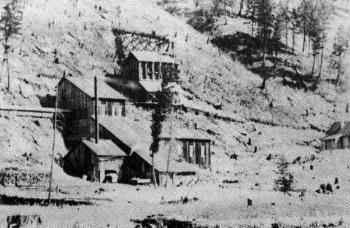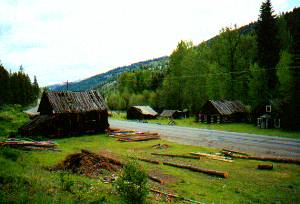
![]()

Bodie Mill, around 1910
In 1888, Henry Dewitz attracted by the mineralized outcrops in the region soon established a log building settlement at the mouth of Bodie Creek. By 1896, Bodie was firmly established with the usual restaurant, general store, smithy shop, livery barn, and several log cabins. Henry Dewitz struck the big lode barely a mile north of Bodie.
The pocket of ore purportedly yielded an amazing $80,000 in gold. The Dewitz brothers sold the mine to the Wrigley Brothers. The Wrigley's built a reduction mill in 1902. The mine began to make a name for itself and was called the Bodie Mine.
By 1917, however the pockety nature of the ore and a slow decline in values forced the Bodie Mine to close. For seventeen more years Bodie lay abandoned. Then an increase in the price of gold triggered activity in the Bodie Mine once again.
But finally, in 1944, after producing an estimated $1,250,000.00 in gold, the Bodie Mine shut down for good. Since then the mill has fallen into decay but the camp completely abandoned, still stands as a classic ghost town.

Henry DeWitz, built the first building, a log cabin, for himself to live in, around 1896.

Bodie, one of Okanogan Countys many historic ghost towns.

Bodie Hotel, it is thought the town was named for a mine in Montana.
Bodie Mine
In the spring of 1969 the Bodie Mine was purchased by the Geo-Mineral Exploration Company. Located near State Highway 30 the properties are approximately 11.5 miles from Wauconda Junction, which is 16.9 miles from Republic, Washington.
The Bodie Group is composed of five patented claims and 224.45 acres under mineral prospecting lease from the State of Washington. The claims are located in Okanogan County, in Section 3, Township 35 N., Range 31 E. The state lease encompasses the south half of the northeast quarter and the east half of the southeast quarter and the Lots 5 and 10 of Section 34, Township 39 N., Range 31 E.
The Bodie Mine was discovered in 1890, and had operated intermittently until 1944 when it was shut down. Geological reports compared the ore coming from the Bodie Mine to the ore originating from the Knob Hill mine at Republic, Washington. If the geology of the deposit were similar to Knob Hill, a substantial preserve of high-grade ore should still exist below the 400 level, the lowest level worked by previous operators.
Of further interest, a "tailings dump" from previous milling operations exists to this day. A current report contains an estimate of a minimum of 11,000 tons of tailings having an overall average of gold and silver value of 3.27 ounces per ton. Additionally, available records indicate that the mine was operated from the time of its discovery until around 1916 when war conditions caused its closure. Apparently, the property remained dormant until 1934 when it was reactivated and worked until 1938. There is a record of 302 tons having been produced between the years 1940 and 1944.
There are however, no existing, substantiating records for this production time period. Old mine maps dated from the year 1937 indicate that there is greater than 4,500 feet of tunnels on four different levels of the mine. Moreover, there is an 800-foot crosscut below the older workings. The five levels of the mine are designated as the 200, 250, 300, 400 and 600 levels. On the 200 level, there is 400 feet of tunnel, both drift and crosscut, which is presently accessible. Only 70 feet of the 250 level crosscut is open. On the 300 level, 160 feet is open and available for mapping. On the 400 level the entire crosscut and a portion of the south drift is accessible for approximately 600 feet.
On the 600 level, the entire crosscut, 800 feet long, is open and accessible. This means that there is a total of approximately 2,070 feet of tunnel presently open, and all of the tunnels consist of hard rock with a minimum of supporting timbering.
In addition to the old tunnels there are stopes and raises that connect the 400 level with the surface. In some places these open stopes are as much as 30 to 35 feet in width and they have effectively made many of the drifts along the vein inaccessible. The roads to both the 200 and 400 levels of the Bodie property have been cleared of fallen trees and the workings on these levels have been investigated. The acceptable workings have not yet been mapped, but this will be completed in the near future. The workings on the 200 level that have not caved in consist mainly of short crosscuts into the vein. The vein has been stoped both through the surface and apparently to at least the 300 level. No portion of the vein was accessible on this level for sampling at the time of this report.
Bodie (Northern Gold Corp...Last production) excerpts:
Free gold, pyrite. Deposit: Finely disseminated ore in quart-calcite vein. Vein much altered and leached near surface, and is similar to those in Republic Dist. Veins are in tuff and andesine. One vein averaged 4 feet wide. Dev: Several thousand feet of workings on 4 levels. Assays: 302 tons produced in 1940-1944 returned $9,770 at $32.35/ton. Ore said to average $10/ton Au. Prod: 1906, 1907, 1909-1911, 1914, 1915, 1934-1944.1935-1944 66,032 tons.
![]()
